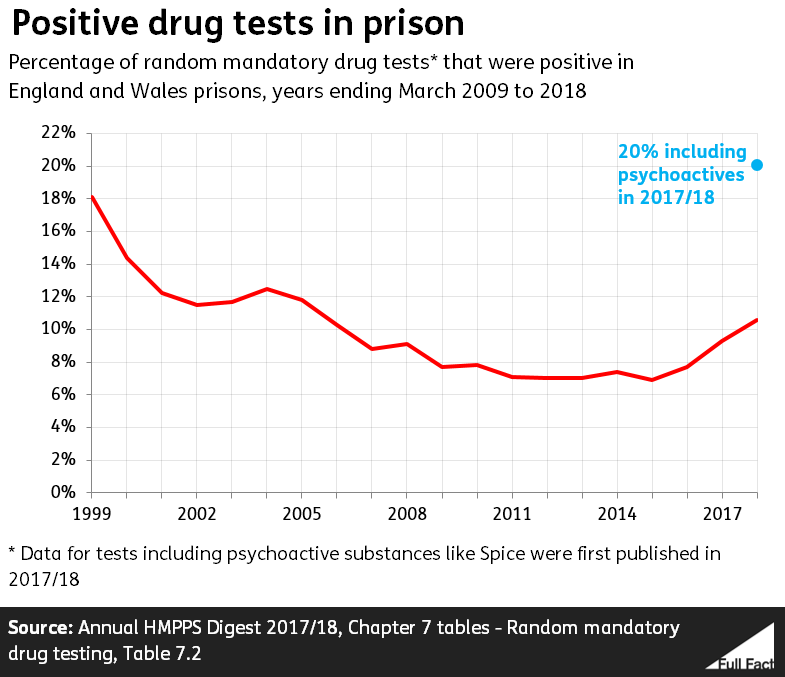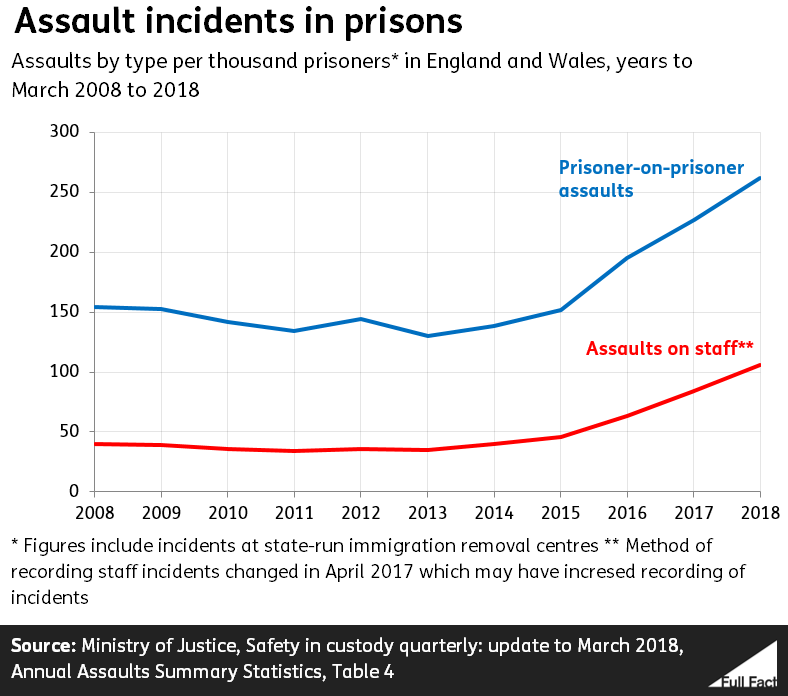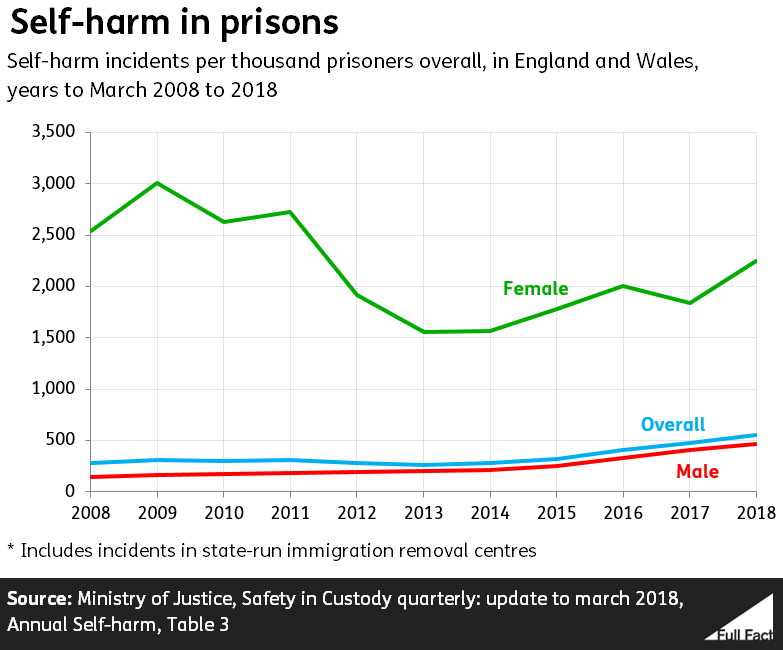What was claimed
There were 46,850 self-harm incidents in prisons in the year to March 2018, up 16%, and an average of 128 recorded a day.
Our verdict
Correct.
There were 46,850 self-harm incidents in prisons in the year to March 2018, up 16%, and an average of 128 recorded a day.
Correct.
Violent incidents rose to 31,025, up 16%, of which 9,003 were on staff, which is up by a quarter in the year to March 2018.
Correct. Assaults on staff were up a quarter from around 7,160 to 9,000.
The amount of times drugs were found in prisons across England and Wales rose by 23% in one year. 20.4% of drug tests came back as positive.
Correct, including tests for psychoactive substances like spice.
“More than 46,850 self-harm incidents were recorded in the year to March 2018, up by 16 per cent on the previous year, with self-harm now recorded on average 128 times a day.”
“Violent incidents meanwhile rose to 31,025, up 16 per cent, and of which 9,003 were assaults on staff – a figure that has soared by more than a quarter (26 per cent) in the 12 months to March.”
The Independent, 26 July 2018
“The amount of times drugs were found in prisons across England and Wales rose by 23% in one year, Ministry of Justice figures reveal…”
“The figures for the year between March 2017 and March 2018 also reveal that 20.4% of drug tests came back as positive.”
Sky News, 26 July 2018
Assaults of all types and self-harm incidents are up in prisons, as are positive drug tests, and the number of times drugs have been found.
There were just under 83,000 people in prisons in England and Wales at the start of August 2018.
Honesty in public debate matters
You can help us take action – and get our regular free email
The Ministry of Justice aims to randomly drug test 5% or 10% of prisoners in each prison every month.
Around 54,400 tests were administered in 2017/18. 11% of the results proved positive for “traditional drugs”, like cannabis, opiates, cocaine and methadone.
Positive tests for traditional drugs have risen slightly from 9% in 2016/17. This latest year had the highest proportion of positive results since 2004/5 when 11.8% were positive.

If you include positive results for psychoactive substances, like ‘Spice’, 20% of them were positive.
This is the first year the psychoactive test results have been published so we can’t compare that 20% figure over time. The most common positive test result in 2017/18 was for psychoactive substances—60% of positive samples contained them. Second was cannabis, at 28%. Some test results were positive for multiple substances.
The random drug tests are mandatory—although a prisoner can refuse to take it and face a disciplinary procedure. Failing the test is a disciplinary offence, which could mean a longer sentence.
The number of times drugs have been found in prisons has increased over the last five years.
There were 13,100 incidents where drugs were found in prisons in 2017/18, up 23% on the year before when there were around 10,700. That figure’s been increasing since 2012/13 when drugs were found just under 4,300 times.
Psychoactive substances were also the type of drug found most often.
There were 31,000 assault incidents in prisons and state-run immigration removal centres in the year to March 2018. 22,400 of these were prisoner-on-prisoner assaults and 9,000 were assaults on staff.
There were 364 total assaults per thousand prisoners in 2017/18. That’s roughly the same as the number per thousand male prisoners, though for women (who make up about 5% of the prison population) it’s slightly lower.
There were 46 per thousand prisoners, of what the Ministry of Justice classes as “serious assaults”. This includes sexual assault, anything that results in being an inpatient at a hospital, concussion and other specific types of injury like broken noses and lost teeth.
For prisoner-on-prisoner assaults, there were 262 per thousand, and 106 assaults on staff per thousand prisoners.

The Ministry of Justice changed how assaults were recorded in April 2017. It said this simplified how incidents involving staff are identified but it “is possible this has increased the recording of incidents”.
There were 46,900 incidents of self-harm recorded in prisons in England and Wales in 2017/18, up 16% on the year before. Per day, that works out as 128 incidents. This is the highest it’s been over the last ten years, when this data series began.
Self-harm is defined as “any act where a prisoner deliberately harms themselves, irrespective of the method, intent or severity of any injury”. The figures may include some but not necessarily all attempts at suicide.
There were around 11,900 “self-harming individuals” in prisons overall.
Again, looking at incidents per thousand there were 549 incidents of self-harm per thousand prisoners in 2017/18 in prisons overall.
Female prisoners have long been more likely to self-harm, and more often than those in male prisoners. There were 467 self-harm incidents per thousand male prisoners in 2017/18. For women, this figures was just over 2,200. There were 308 self-harming women per thousand female prisoners in 2017/18.

Full Fact fights for good, reliable information in the media, online, and in politics.
Bad information ruins lives. It promotes hate, damages people’s health, and hurts democracy. You deserve better.